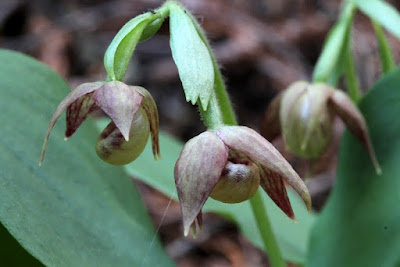A photographic record of the beautiful and often rare native orchids that can be found in our area.
Tuesday, August 7, 2012
Brownie Lady's Slippers near Greenwater
Wednesday, July 26th, was our day out for the week (we try to get out once a week in the summer), and we decided to explore the Greenwater area near Mount Rainier and look there for the Clustered or Brownie Lady's Slipper, a native orchid that we had not seen in bloom yet this year.
We left at 3:00 am and drove down to our destination and then up several Forest Service roads, arriving at our trailhead before 7:00 am. We took our time, stopping for coffee and for breakfast and for for pictures along the way. Along the FS roads we saw a number of other orchids but did not stop for them until later.
This was a good day for orchids. We saw ten different species and a color variety of one of them along with many other wildflowers. One of the species was not yet in bloom and one nearly finished with only a few flowers still hanging on, but this was the star of the show.
The Clustered or Brownie Lady's Slipper is the smallest and rarest of our native Lady's Slippers and this location is protected. Usually we find this hidden by other vegetation because it is so small, but here the plants were growing in abundance on an open bank.
The plants we saw were 10-15 cm tall with the usual two opposite oval leaves and with one to three flowers per plant and with the usual range of color from green to a rich mahogany purple. The plants seemed to be thriving in this location with many new seedlings evident.
Subscribe to:
Post Comments (Atom)













14 comments:
Que linda, não conhecia
obrigada por compartilhar
abraços e uma linda noite
I keep meaning to get back to this spot and to visit the classic hike north of there.
that slope is pretty amazing for photography, isnt it.
Thank you for commenting. This, though not as showy as some of our Lady's Slippers, is very dainty and beautiful in its own way.
That is an incredible place. We found ten orchids that day, but this was the best and the location is full of them.
Thank you for showing this beauty, what a treat to see it growing !
Thanks for commenting, my friend. This is quite rare and hard to find, so it was indeed a treat to see it growing here in such abundance.
Hello,
I am Martin from Germany. Awesome blog and beautiful photos. I love native orchids (in fact I am in a native orchid conservation club in Germany - the AHO).
Well we only have one Lady's Slipper species - the yellow Lady's Slipper (Cypripedium calceolus). Always nice to see the variety in other countries.
I have seen quite a few orchid species on my last trip through the pacific northwest and the canadian rockies.
I am still having trouble identifying some of the species I found since I went there well past the flowering season. Maybe one of the experts here can give me hints.
Also: Is it okay to link to your blog from my website?
Thanks for all the work you put in this site.
Martin
Hi Martin,
It certainly is okay to link to my blog, especially if it helps you with identifications. Perhaps I can help with the ID's. Appreciate your looking and commenting.
Regards,
Ron
Hello Ron,
you can find pictures of some of the orchids I found in Canada here: http://www.lichtschnapper.de/blog/?p=429
We went there in September and started in Seattle, so we were late to the game.
Well... I think Goodyera oblongifolia is obvious, so is Spiranthes romanzoffiana. I have no idea what Cypripedium, Platanthera and Listera species I found. I also have no hope of identifying that Corallorhiza on my own. The plants were found in Jasper NP (Miette), Yoho NP (Emerald Lake) and Wells Grey. I so need to come back some day preferably in July/August.
Especially Platanthera in America seems about as crazy and hard to identify as Epipactes or Dactylorhiza in Europe.
If you rather want to use email:
martin_hild at web.de
Regards,
Martin
Hello again, Martin.
As you may have noticed, I did my best to identify the orchids you had posted. Some are obvious and some are not. As to the green-flowered Platantheras, they are indeed difficult to distinguish and in fact interbreed so that there are always overlapping types. I didn't mention a Corallorhiza, but I believe #8 on page 1 is C. maculata.
I have noticed and I am rather happy you did. We only have two Platanthera species, which are easy to distinguish by the flower. Hybrids between the two exist, but are also kind of easy to recognize.
We only have Corallorhiza trifida in Germany, so this is also easier, but don't get me started on Epipactes or Dactylorhiza. ;-)
Thanks again!
We have about a dozen Platantheras here in the Northwest. Several of them are easy to distinguish and several can be identified by their range, but generally those with green flowers are difficult. I still have to look them up and examine them carefully and even then I am not always sure.
We have eight Coralroots, if you count varieties, and most of these are easy, though the varieties of Corallorhiza maculata are not always so easy. There is a huge amount of variation in some of them, but the species are quite distinct. I enjoy trying to figure them out, though.
Wow, I love the pendulous inflorescence of this one. Great colour too.
Not only beautiful but rare. I know of only three locations for this species.
Post a Comment